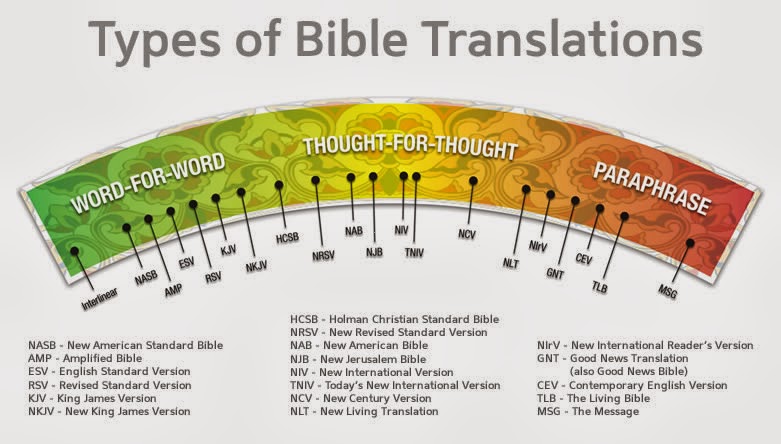
Picture a sliding scale from left to right. Every translation fits somewhere along that scale. At one end of the scale literal translations and on the other extreme are dynamic translations.
Literal translations relay the actual words used in the original language without being overly concerned with ease of reading or conveying the authors’ meaning. Emphasis: what did the original author say word-for-word verbatim.
Dynamic translations try to relay the authors’ meaning without being overly literal—they express what the author means, not what he said. Emphasis: what does the author mean without concern for using their actual words.

If you are translated the English into Russian literally you will render it “I shot myself in the foot.” But if you do, the Russian gets the completely wrong message They think we are talking about a medical condition.
But if you want the Russian to understand the meaning of the author’s text you will not use the literal words but translate it to something like, “I did something stupid and made a fool of myself.”
With our example, the first is literal and the second is dynamic. The first emphasizes what the author says, the second what the author means. All translations fit somewhere in between.

Want the best? Check out the Didache Bible published by Ignatius Press. I have purchased many of them to give to friends and priests. You can learn about it here. It is on the literal side of the sliding scale but becomes a dynamic translation as well by providing a plethora of footnotes and Catechism quotes.
Many suggested I include the Douay-Rheims translation. I don’t use this much myself because it a translation of a translation and using old manuscripts and language. It is like translating Russian into Spanish and then Spanish into English — a hundred years ago. I use it sometimes for its strong Catholic emphasis in certain passages.
Again, as I said, it is best to read many translations side-by-side and for a strong Catholic emphasis, the Douay-Rheims is a good version to have in your stack. Another might be the English translation of the Greek Septuagint which was the Bible of the early Church.
The chart shows many translations, most of which are Protestant translations – but gives you the idea. The RSV is on the left end of the chart whereas the NAB is under the “thought-for-thought category. A paraphrase is not really a translation but the far extreme of the dynamic where the translator puts things in his own words often with biases and personal opinions.

-
Save
If you want the best-of-the-best check out the Verbum Catholic Bible Software that allows you to compare many translations side-by-side and to instantly access the original languages with English explanations. Nothing else like it.
Visit www.Verbum.com/steveray. Use Promo Code STEVERAY8 and get 10% off.
Another helpful article on the science of translation and which are preferred.



This Post Has 24 Comments
It is strange that you do not also recommend the classic Catholic translation, the Douay-Rheims. This version has many advantages that compensate for some of its literary weaknesses. First, it is based directly on the Vulgate, which was the approved translation of the Catholic Church for 1,500 years, and the version quoted by countless saints, doctors, teachers, scholars. If one wishes to be conversant with the Latin Christian tradition, one simply cannot bypass the Vulgate (and therefore the Douay for English). Second, there are possible meanings of Scripture that Church tradition used to call upon that have been more or less systematically excluded from more recent translations, partly due to questionable assumptions about which Hebrew and Greek base texts to use. Having the Vulgate/Douay on hand is a good counterbalance.
STEVE RAY HERE: Peter, good point. I agree with you and concur completely and will revise the blog to reflect that. I don’t use it much myself but use it when looking at a passage where I want various emphasis. It is a translation of a translation. It is like translating Russian into Spanish and then from Spanish into English. What is great about it is the Catholic emphasis of many passages. Others consider it biased, but it is helpful for Catholics.
Where’s the Douay-Reims?
Paulb Whitlow Jr, that was also my question.
This great information but there is another layer of complexity to the question. This is all about the translation strategy, but someone might assume whatever the strategy all these translations are based on the same original manuscripts–but this is not so. Compare Douay-Reims, RSVCE and NABRE in Ben Sirach and you will quickly discover that modern translations are based on more recent manuscript finds. This is super important for the dead sea scroll materials of the OT which are 1000 younger than the previous manuscripts. This also effects the KJV.
I would also quibble with the comment, “With our example, the first is literal and the second is dynamic. The first emphasizes what the author says, the second what the author means.” The literal is only “what the author says” in the original language. Any translation literal or dynamic is an equivalent in a second language. The question is which is a better or more accurate equivalence in the secondary language? Intuitively many people assume that the literal is better but as your foot shooting example points out this is not so. The literal is great as a cheat to read along with the original but otherwise is can be very misleading. Often the grammar suggests something quite different for a wooden literal meaning.
STEVE RAY HERE: You are absolutely correct. I could have written a ten page blog with a lot of classifications and qualifications but then no one would read it. I tried to keep it simple and concise. But you are correct and I am glad you posted this comment for those who want to dig deeper.
It is also why I suggest not just one translation but a “literal” and a “dynamic” and others as well to better get the whole story. Thanks!!
You can find that translation on CatholicCompany.com I’m sure it’s elsewhere as well.
Spell check: Greek Sepuagint?
Otherwise, good info. We use the Didache at our Catholic School. Daily Mass, classical education.
I was delighted to see the references to various Catholic Bibles. My bible is the Douay-Rheims. However, I have several other bibles that I refer to from time to time. My question is this; IF the compilation of the original manuscripts, written and based on the writings and teachings of the earliest Christians, was Catholic, I do not know when the first complete Bible was actually compiled, but my understanding is that Christianity and Catholic were basically synonymous I can understand the tiny differences in translating from the Hebrew, Greek, or Latin, but weren’t all these compilations and translations done be followers of the Catholic religion?
Upon my first reading a KJV, authorized by an egotistical King almost 1500 years later, I found a few radical differences I have never been able to reconcile with my 12 years of Catholic Education and further studies on my own through my adult life.
How can any off shoot from the Catholic religion justify the differences, or changes? They do not honor Mary as she surely deserves to be honored, and stating that Mary and Joseph had other children following the birth of Jesus.
Can you help me to understand this? Thank you.
STEVE RAY HERE: Actually it is very easy to explain. The word Protestant comes from the word “protest” and that is what they do. They do not hesitate to add their bias into the translation. You are very perceptive.
I think you are missing a few points. The footnotes are just as important as the Bible you use. There is no better than the Haydock Bible. As for the Douay Rheims, it is taken from a translation is true, but the Vulgate was translated by St. Jerome who had access to more documents lost to us now, and lived in Israel at the time when Jewish scholars could help him to more accurately convey the understanding (Aramaic still a spoken language in his day). The Haydock Bible can be found here : http://haydock1859.tripod.com/
DON’T WASTE YOUR TIME LOOKING FOR MODERN BIBLES AND MODERN COMMENTARIES, THE BIBLE OF THE bibles OF ALL TIME IS ”THE ORIGINAL DOUAY RHEIMS BIBLE” 1582,1609-10 TRANSLATED FAITHFULLY INTO ENGLISH, NOW FOUND INTO MODERN ENGLISH AT LULU.COM , AND THE NUMBER ONE BIBLE IS THE HAYDOCK BIBLE OR DOUAY RHEIMS VERSION,AND ONE OF THE BEST COMMENTARIES IS THE CORNELIUS LAPIDE
STEVE RAY HERE: Love the Douay Rheims and Lapide, but one has to realize that this translation is based on older documents and old English. It is good to read alongside more modern translations that are still faithful to the original text and the tradition. It is as I said in the article.
not all the translations are still faithful the majority changes a lot of the words of God for example when we go to the Latin mass we pray the holy Mary and say full of grace but in some new modern translations say “favorite one” including “the new American bible” that’s protestant others have changed charity for the word “love” and many others that will take to much time to write. The only one that I would buy other than the “Douay Rheims bible” is the revised standard version Catholic second edition.
STEVE RAY HERE: Did you read my article? I recommend the RSV-CE and the Douay. I do not think it is a good idea to read only one translation since translations are fraught with danger as I explained in my article. Yes, read the Douay and the RSV-CE. Be smart and read others side-by-side to get the full spectrum. The NAB is very good in many ways. It is the only translation that makes it apparent that Jesus uses the Divine Name when he says, “I AM!”
How about the Knox Bible? I have the Douay Rheims and the New Catholic Answer Bible (NAB), but have been considering obtaining the Didache Bible (Ignatius Press) and the Knox Bible to assist in bringing more clarity to those passages I find difficult to comprehend. Do you have an opinion on the Knox translation?
The Church recommends recent translations given updated scholarship, and preferably something that can be used for lectionaries. That means NABRE, NRSV-CE, RNJB. etc. If you can, wait for the updated NABRE, the equivalent of NRSV-2CE, and a CTS Bible based on the RNJB.
Dear Steve Ray;
What about the Jerusalem Bible?
If it is good enough for Mother Angelica and Fr. John Hardon SJ then certainly it's good enough for us?
STEVE RAY HERE: The Jerusalem Bible is an excellent English Catholic version of the Bible and the Psalms were even translated by Tolkien. However the New Jerusalem Bible has a lot of inclusive language and is not to be preferred.
Want the best? Check out the Didache Bible published by Ignatius Press. I have purchased many of them to give to friends and priests. You can learn about it here….
both links are the sea: dead
I would just like to give some examples of the systematic abuse used by the tricky modern Protestant translators. There are those who choose the words “deeds” or “works” for the same Greek word to defend standard Protestant theories. They also use the word “instructor” when Jesus tells his apostles (before Pentecost) not to allow themselves to be called “teachers.” After Pentecost in Corinthiams we see that there was actually an office of “teachers.” This game of words helps to justify the Protestant horror of the word Father for priests — if we have teachers (after Pentecost), why not fathers? Anyway, Paul solved that problem by insisting that although the faithful might have many teachers, they had only one father — St. Paul! Another trick is to use the word “teaching” rather than “tradition” (another no-no, shame on the Catholics for valuing tradition) when in fact the Greek word remains the same for tradition and their mistransalation: teaching. Then there are more subtle tricks like calling the Apostle Jude the son of James when the text actually says “of James” There is a whole story behind that which is too long for this intervention.
The wedding at Cana dialogue twixt Mary and Christ shows the tragedy of what happens when non literal or sense for sense translations win in virtually every Bible. Because Augustine and Chrysostom both saw a negative moment from Christ to Mary, most English translations simply played off those famous interpretations…and the result is a petulant Christ in all sense for sense translations. Christ literally used a rare idiom…” what to me and to thee, woman, my hour has not yet come.” Mary hears a sure yes in that. How? Because Christ was using “hour” for the hour of His passion as it is used throughout John. He was not saying it is not my hour to go public because He had just brought the first chosen disciples with Him publicly to a wedding. Mary walked up to Him with fear in her face and in her tone because since He had brought the first disciples to the wedding feast, she began to worry as to how soon Christ would arouse hatred and be arrested and suffer per Simeon’s warning long ago. So Christ saw that anxiety on her face and in her tone and that is why He was actually reassuring her…”what to me and to thee, woman, my hour (to suffer) has not yet come.”
Bingo…that is why Mary heard a yes. It was a yes. Christ used the word “woman” later in John when consoling a crying Mary Magdalene…so it was for Him a gentle word.
Further proof? Go to the 2 Kings 3:13 only in the Vulgate (the Douay R. goofs here though not in John as I remember). Eliseus uses the rare idiom to the King of Israel “what to me and to thee”…and he uses it just before Eliseus performs a miracle of producing water for horses etc. which water looks red to the distant Moabite enemy. Mary and Christ must have gone over that passage somewhat prior to Cana so that Christ was assuring her and simultaneously hinting to Mary by the idiom that water was going to be involved in His miracle and was going to turn red in some sense. Hence Mary was being reassured by Christ/ was getting a hint from Christ that like the Eliseus miracle, water would be involved/ and hence after both levels hit her she knows the servants will be involved…probably with the water jugs.
1961 New English Bible
One problem with the newer translations is that they do not make a distinction between “you” and “thou” – the plural and the singular. There was a difference in the original languages, and it seems foolish to ignore it.
“Dynamic” translations strike me as completely wrong because they involve accepting the translator’s word about what the passage actually means. What you wrote about the Didache Bible (“It is on the literal side of the sliding scale but becomes a dynamic translation as well by providing a plethora of footnotes and Catechism quotes”) makes the most sense. The translator is not inserting himself into the text to quite the same extent; he’s giving his explanation but not pretending that his explanation is in the text.
I have a Protestant minister friend who uphold of course all the traditional Protestant misinterpretations of the Bible . On business trips I sometimes give bibles to poor churches. He volunteered to give some too and I politely told him thank you bi they must be Catholic versions to which he angrily argued there is no difference and he can prove any Protestant point from any bible.
Forward a few months to us discussing “brothers of Jesus” . I whipped out my RSV which he agreed was a good translation since Protestants use it too and as soon as I read “brethren” he leaped out of his chair shouting “you can’t do that you can’t do that !!!!! It’ reads brothers! “ And that’s as far
As the discussion went since he spent the rest of the night ranting about the word brethren
NAB is under the “thought-for-thought category. A paraphrase is not really a translation but the far extreme of the dynamic where the translator puts things in his own words often with biases and personal opinions. Given this explanation, why is the NAB, officially used by the Church for the Mass Liturgy and the Divine Office?
What about the Christian Community Bible? I like it a lot.
STEVE RAY HERE: If remember correctly that is the Filipino translation of the Bible which I was more familiar with 15 years ago When I spent a lot of time in the Philippines. I remember thinking it was a bit weak in some of the translation and especially in the notations and footnotes. But I would have to look at it again to confirm that.
@Jeffrey Needle. I lived in the Philippines for about 12 years. Problem with their translations is that the language itself is limited by an approximately 30000 word vocabulary, that also contains many Spanish words. Its simplicity is a plus when trying to communicate simple concepts in easily understood terms. In seminaries, the instructional language is English which make it easy to use available foreign translations.
Do you have any experience with and/or opinion about the Navarre Bible?
STEVE RAY HERE: Yes and I love the Navarre Bible. I have the complete set. I wish it was a bit more thorough and a bit deeper but what they did is excellent and I love the set
Hello Steve,
Do you know anything about this new “New Catholic Version” by Catholic Book Publishing (aka St. Joseph Editions)?
https://catholicbookpublishing.com/read/new-testament-new-catholic-version
Comments are closed.